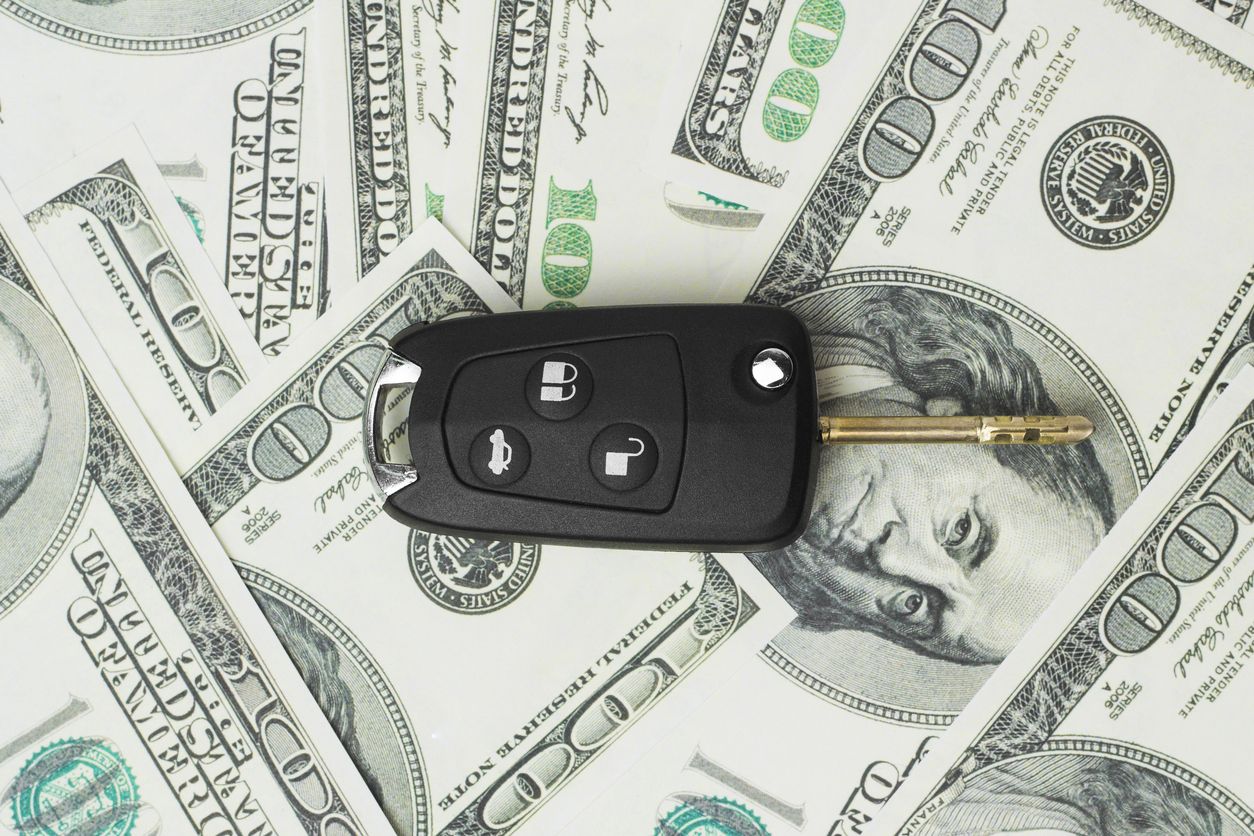Introduction
Trading in a car is a common practice when it comes time to upgrade or purchase a new vehicle. It involves selling your current car to a dealership in exchange for credit towards the purchase of a new one. This process offers convenience and simplicity for those looking to upgrade without the hassle of selling their car privately.
When deciding to trade in a car, it’s important to understand how the process works and what factors affect the trade-in value. This knowledge can help you maximize the value of your trade-in and make a more informed decision when purchasing a new vehicle.
In this article, we will explore the ins and outs of trading in a car. From understanding the benefits of trading in to determining the value of your trade-in, we’ll cover everything you need to know to navigate the trade-in process successfully.
Whether you’re looking to upgrade to a newer model, downsize to a more fuel-efficient vehicle, or simply want a change, trading in your car can be an excellent option. By following some simple guidelines and being prepared, you can make the most out of your trade-in and ensure a seamless transition to a new car.
Now, let’s dive deeper into the world of car trading and discover how the trade-in process works, including tips and strategies for getting the best value for your vehicle.
What is trading in a car?
Trading in a car refers to the process of selling your current vehicle to a dealership in exchange for credit that can be applied towards the purchase of a new car. It is a convenient and straightforward option for those looking to upgrade or purchase a different vehicle without the hassle of selling their car privately.
When you trade in a car, the dealership assesses the value of your vehicle and offers you a trade-in value. This value is then deducted from the price of the new car you wish to purchase. Essentially, the trade-in value serves as a down payment, reducing the amount of money you need to finance or pay out of pocket for the new vehicle.
Trading in a car offers several advantages. Firstly, it simplifies the process of selling your old car. Instead of advertising, negotiating, and dealing with potential buyers, you can simply drive your car to the dealership, receive an offer, and move forward with the purchase of your new vehicle.
Additionally, trading in a car can save you time and effort. Selling a car privately can involve a lot of paperwork, meetings with potential buyers, and the need to ensure the transaction is legal and secure. By trading in your car at a dealership, you can skip these steps and enjoy a streamlined process.
It’s important to note that trading in a car may not always get you the highest value for your vehicle. Dealerships typically offer lower trade-in values compared to what you could potentially get if you sold the car privately. However, this trade-off is often outweighed by the convenience and simplicity that trading in provides.
In summary, trading in a car involves selling your current vehicle to a dealership in exchange for credit towards the purchase of a new car. While it may not yield the highest value for your car, the convenience and ease of the process make it a popular choice for many individuals looking to upgrade their vehicles.
Why trade in a car?
Trading in a car offers several compelling reasons for individuals looking to upgrade or purchase a new vehicle. Let’s explore some of the key advantages of trading in your car at a dealership.
One of the main reasons to trade in a car is convenience. Selling a car privately can be time-consuming and involve numerous steps, such as advertising, screening potential buyers, and negotiating a fair price. By trading in your car, you can skip these processes and have a hassle-free experience. Simply bring your car to the dealership, receive an offer, and put that credit towards the purchase of your new vehicle.
Trading in a car also saves you from the stress and uncertainty of waiting for the right buyer. Private sales can sometimes take weeks or even months before finding interested parties. However, with a trade-in, you can complete the transaction on the same day and drive away in your new car.
Another advantage of trading in a car is the potential savings on sales tax. In many regions, the sales tax on a new vehicle purchase is calculated based on the difference between the new car’s price and the trade-in value. This means that the trade-in credit can directly reduce the taxable amount, resulting in lower overall sales tax. This can lead to significant savings, especially if you’re trading in a more expensive car.
Furthermore, trading in a car allows you to avoid the stress and uncertainty of negotiating the price of your trade-in separately from the purchase of your new car. By trading in, you only need to focus on negotiating the purchase price of the new vehicle. The trade-in value takes care of itself, simplifying and streamlining the overall transaction.
It’s important to note that while trading in a car offers convenience, it may not always yield the highest price for your vehicle. Dealerships factor in various considerations when determining the trade-in value, which may result in a lower offer compared to selling privately. However, factoring in the time, effort, and potential savings on taxes, the trade-off can be well worth it for many individuals.
In summary, trading in a car provides convenience, time savings, potential tax savings, and a streamlined transaction process. While it may not result in the highest price for your vehicle, the advantages it offers make it a popular choice for those looking to upgrade or purchase a new car.
How does the trade-in process work?
Understanding how the trade-in process works is essential to navigate it successfully. Here’s a step-by-step breakdown of how the trade-in process typically unfolds:
1. Research your car’s value: Before visiting a dealership, it’s helpful to have an idea of what your car is worth. Utilize online valuation tools or check similar listings to get an estimate of its market value. Keep in mind that the trade-in value will likely be lower than the private sale value.
2. Visit the dealership(s): Once you have an estimate of your car’s value, visit one or more dealerships to get trade-in offers. It’s recommended to visit multiple dealerships to compare offers and negotiate the best deal.
3. Vehicle appraisal: At the dealership, a trained appraiser will assess your car’s condition, mileage, features, and any repairs or maintenance history. They will also inspect the exterior and interior for any wear and tear. This appraisal process helps determine the trade-in value.
4. Trade-in offer: Based on the appraisal, the dealership will provide you with a trade-in offer. This offer is the amount of credit applied towards the purchase of your new vehicle. You can negotiate this offer, and it’s beneficial to have knowledge of your car’s market value to ensure a fair deal.
5. Apply trade-in credit: If you accept the trade-in offer, the credit will be deducted from the price of the new vehicle you’re purchasing. This reduces the amount of financing or cash required.
6. Complete paperwork: As with any car purchase or trade-in, there will be paperwork involved. This includes transferring the title of your old car to the dealership and completing the necessary forms for the purchase of the new vehicle. Ensure you review and understand all the paperwork before signing.
7. Transfer ownership: Once the paperwork is completed, the dealership will take possession of your trade-in. They will handle the necessary paperwork with the appropriate authorities to transfer ownership out of your name.
Remember, it’s important to be informed and prepared during the trade-in process. Research your car’s value, visit multiple dealerships, negotiate the trade-in offer, and carefully review all paperwork to ensure a smooth and satisfactory experience.
By following these steps, you can navigate the trade-in process with confidence and make the most of your trade-in value towards the purchase of your new vehicle.
Determining the value of your trade-in
Determining the value of your trade-in is a crucial step in the trade-in process. The trade-in value plays a significant role in determining how much credit you will receive towards the purchase of a new vehicle. Here are some factors that influence the value of your trade-in:
1. Vehicle condition: One of the essential factors that affect the trade-in value is the overall condition of your vehicle. Dealerships will inspect your car for any significant mechanical issues, body damage, or signs of wear and tear. Cars in excellent condition, both visually and mechanically, tend to fetch higher trade-in values.
2. Age and mileage: The age and mileage of your car also impact its trade-in value. Typically, newer cars with lower mileage will have a higher trade-in value compared to older vehicles with high mileage. Buyers prefer cars that are still within the warranty period and have been driven relatively less.
3. Market demand: The demand for your car’s make, model, and trim level in the market also influences its trade-in value. Popular models with a high demand will generally have better trade-in values compared to less sought-after vehicles.
4. Vehicle history: The car’s history, including maintenance records, accident history, and title status, can also affect its trade-in value. A well-documented service history, a clean accident record, and a clear title can increase the vehicle’s value, while any negative history can reduce its value.
5. Additional features and upgrades: Any additional features or upgrades that enhance the vehicle’s functionality or appeal can positively impact its trade-in value. Features such as leather seats, advanced safety systems, or technology upgrades can increase the value of your trade-in.
It’s important to note that the trade-in value offered by dealerships may not always match your expectations or the private sale value of your vehicle. Dealerships factor in various considerations, such as potential reconditioning costs and the need to make a profit when determining trade-in values.
To get an idea of your car’s value before visiting a dealership, you can use online valuation tools or check similar listings in classified ads or car-selling websites. These resources can give you a rough estimate of your car’s worth, helping you negotiate a fair trade-in offer.
In summary, the trade-in value of your vehicle is influenced by factors such as its condition, age, mileage, market demand, vehicle history, and additional features. Understanding these factors can help you evaluate the trade-in offer from a dealership and make an informed decision about the value of your trade-in.
Understanding how trade-in value is determined
Trade-in value is determined by a combination of factors that dealerships consider during the appraisal process. While the exact methods used may vary between dealerships, here are some common factors that influence the trade-in value:
1. Market conditions: Dealerships take into account the current market conditions and demand for specific makes and models. If there is high demand for the type of car you’re trading in, the trade-in value may be higher.
2. Vehicle condition: The overall condition of your car plays a significant role in determining its trade-in value. Dealerships inspect the exterior for any scratches, dents, or paint damage, and the interior for the cleanliness and wear on the seats, carpets, and dashboard. Mechanical issues, such as engine problems or transmission malfunctions, can also impact the trade-in value.
3. Mileage: The number of miles driven on your car affects its trade-in value. Generally, vehicles with lower mileage tend to have a higher trade-in value. This is because lower mileage suggests less wear and tear and potentially a longer lifespan for the next owner.
4. Vehicle age: The age of your car is another important consideration. As a general rule, newer vehicles tend to have a higher trade-in value. However, depreciation also plays a role, and the value of a car decreases over time. The rate of depreciation can vary based on the make and model of the vehicle.
5. Vehicle history: Dealerships will typically check the vehicle history report, which includes information about any accidents, previous ownership, and service records. A clean history with no accidents or major repairs can increase the trade-in value, while a history of accidents or subpar maintenance may result in a lower offer.
6. Options and features: Certain features and options can have an impact on the trade-in value. Upgrades such as leather seats, navigation systems, or premium sound systems can increase the value, as they make the car more appealing to potential buyers.
7. Seasonality: Trade-in values can also be influenced by seasonal factors. For example, convertible cars may have higher trade-in values in the spring and summer when demand for these types of vehicles is higher.
It’s important to note that the trade-in value offered by dealerships may differ from the private sale value. Dealerships consider factors such as potential reconditioning costs, profit margins, and market demand when determining trade-in values. However, understanding the factors that influence trade-in value can help you evaluate the offered value and negotiate if necessary.
In summary, trade-in value is determined based on market conditions, vehicle condition, mileage, age, vehicle history, options and features, and seasonal factors. By understanding these factors, you can better understand how the trade-in value is determined and make informed decisions during the trade-in process.
Tips for maximizing trade-in value
When trading in your car, there are several steps you can take to maximize its trade-in value. Here are some tips to help you get the most out of your trade-in:
1. Maintain your car’s condition: Regular maintenance and upkeep can significantly impact the trade-in value. Keep up with scheduled maintenance, such as oil changes and tire rotations, and address any mechanical issues promptly. Keeping your car clean, both inside and out, can also make a positive impression during the appraisal process.
2. Fix minor cosmetic issues: Consider addressing any minor cosmetic issues before trading in your car. Fix small dents, scratches, or paint chips if it’s cost-effective to do so. These minor repairs can improve the overall appearance of your car and increase its trade-in value.
3. Keep service records: Maintain a detailed record of your car’s service history. This includes receipts for routine maintenance, repairs, and any warranty work. Having a documented service history can instill confidence in the appraiser and potentially increase the trade-in value.
4. Remove personal items: Clean out your car and remove any personal belongings before the appraisal. Dealerships prefer to see a clean and empty vehicle during the appraisal process. Removing personal items can also help avoid any potential issues or misunderstandings.
5. Consider marketplace trends: Stay informed about current car market trends. Look for any popular features, models, or vehicle types that have high demand. If your car aligns with these market trends, it can potentially increase its trade-in value.
6. Research trade-in values: Research the trade-in values for your specific make, model, and year before visiting dealerships. Utilize online resources and valuation tools to get a fair idea of what to expect. Armed with this knowledge, you can better evaluate the trade-in offers received and negotiate if necessary.
7. Timing can be key: Timing your trade-in can also affect its value. Consider trading in your car when a new model year is released or when dealerships offer trade-in promotions. These factors can potentially increase the trade-in value or provide additional incentives.
8. Get multiple offers: Don’t settle for the first trade-in offer you receive. Visit multiple dealerships and get multiple offers. This allows you to compare and negotiate for the best possible trade-in value.
Remember, while these tips can help maximize your trade-in value, it’s essential to weigh the trade-off between a higher trade-in value and the convenience of the trade-in process.
By following these tips, you can increase your chances of maximizing the trade-in value of your car and make a more informed decision when trading in for a new vehicle.
Steps to trade in your car
Trading in your car involves a series of steps to ensure a smooth and successful trade-in process. Here are the general steps to follow when trading in your car:
1. Research and gather information: Begin by researching your car’s trade-in value using online valuation tools or checking similar listings. This will give you an estimate of what your car may be worth and help you set realistic expectations.
2. Clean and prepare your car: Give your car a thorough cleaning, both inside and out, before taking it to the dealership for appraisal. Remove any personal belongings and make sure the car is presentable. This can help create a positive impression and potentially increase the trade-in value.
3. Visit multiple dealerships: Take your car to several dealerships to get multiple trade-in offers. This allows you to compare offers and negotiate for the best value. Consider both franchised dealerships and independent used car lots for a broader range of options.
4. Appraisal and negotiation: During the appraisal process, a dealership representative will inspect your car, assess its condition, mileage, and other factors that influence its trade-in value. Engage in a negotiation process to try and secure the highest trade-in offer possible.
5. Consider separate offers for comparison: While trading in your car might be convenient, it’s beneficial to obtain separate offers for comparison. You may choose to explore selling your car privately to gauge its market value and potentially get a higher price.
6. Review paperwork and documentation: Once you’ve accepted a trade-in offer, carefully review all the paperwork and documentation involved in the trade-in process. Make sure you understand the terms, conditions, and any potential fees or obligations.
7. Secure financing for your new car: If you plan to finance your new car, arrange financing before finalizing the trade-in process. This will help streamline the transaction and ensure a smoother transition into your new vehicle.
8. Complete the trade-in transaction: Once you’ve completed all the necessary paperwork and have financing in place, finalize the trade-in transaction. Sign the required documents, transfer the title, and hand over your old car to the dealership.
Following these steps will help you navigate the trade-in process effectively. It’s important to be well-informed, prepared, and open to negotiations to get the best value for your trade-in. Keep in mind that each dealership may have slightly different procedures, so it’s essential to adapt these steps accordingly to fit your specific situation.
By following these steps and utilizing the tips mentioned earlier, you can successfully trade in your car and make a smooth transition to a new vehicle.

























